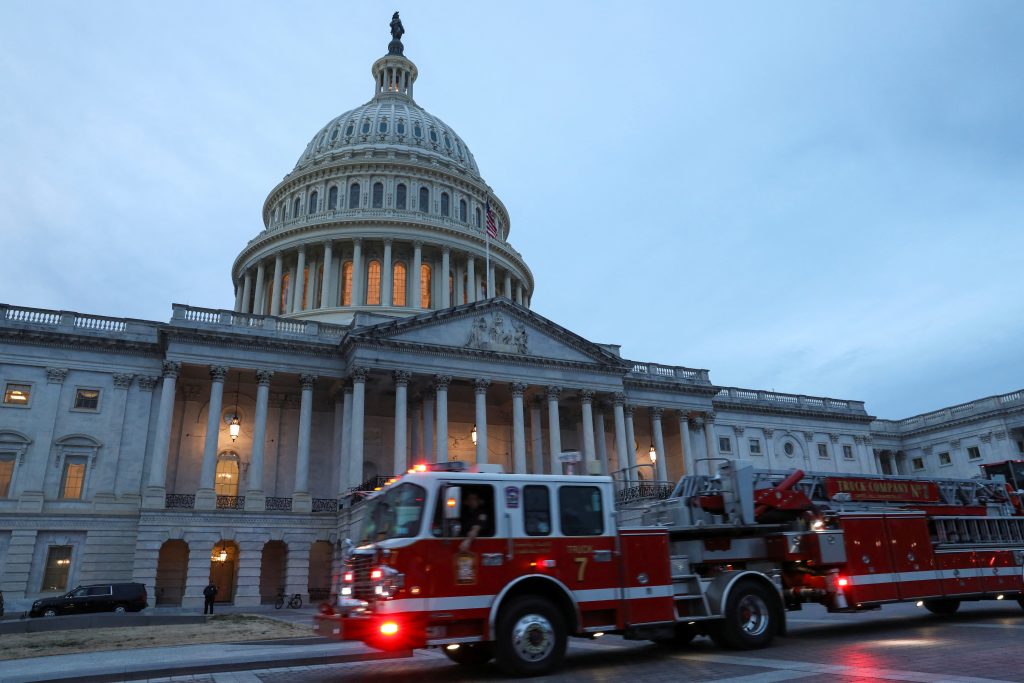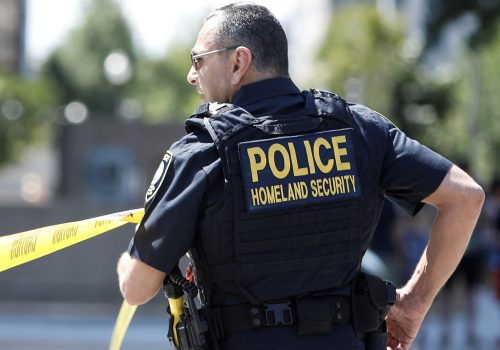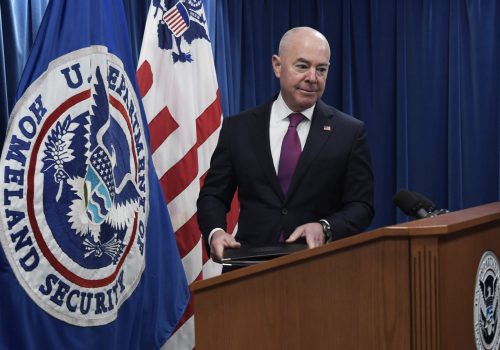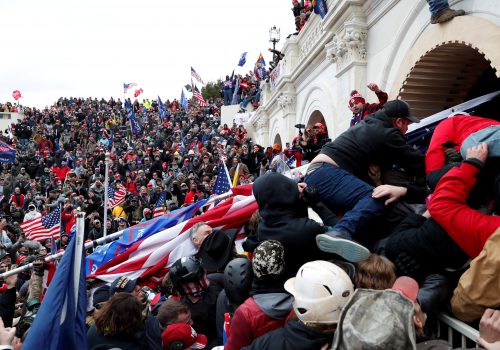In 1736, Benjamin Franklin formed the first trailblazing, community-wide effort to put out fires in Philadelphia. Franklin’s initiative took decades to spread nationwide. Today, the United States has more than 27,000 fire departments and spends $42.5 billion for local fire protection. These efforts save thousands of lives each year, even as most Americans take them for granted—except when a fire breaks out.
The United States urgently needs a nationwide, community-grounded initiative on a similar scale to put out a different type of fire: the threat posed by domestic violent extremists. In May, four members of the Proud Boys were convicted for seditious conspiracy for their role in the January 6, 2021 attack on the US Capitol. On June 1, four Oath Keepers were sentenced for their role in January 6; more than a thousand others have been charged. The May 6 killing of eight people by a white supremacist at a suburban Texas shopping mall, the May 22 attempt by a Nazi sympathizer to attack the White House, and the August 10 arrest of a white supremacist threatening the jury and witnesses in the trial of the Pittsburgh 2018 Tree of Life synagogue shooting—also by an anti-Semitic violent extremist—all highlight the need for more serious national efforts to confront this threat.
As former senior officials with more than forty-five years of combined experience in fighting terrorism at home and abroad in the Departments of Defense, the Central Intelligence Agency, and the Department of Homeland Security (DHS), we know that the country needs the same kind of national determination it had after September 11, 2001 to reduce the threat from violent political extremists.
The number of violent extremists is considerable and the danger they pose to the peaceful resolution of political issues is growing. In addition to the Proud Boys, like-minded extremist groups such as the Oath Keepers shared the spotlight on January 6, when the Oath Keepers were “one of the largest and most prominent organizations of the militia/patriot movement,” according to Stanford University’s Mapping Militants Project. At one time, two-thirds of this organization were former police officers and military members, according to a reportedly leaked membership database.
The participation of former military members in these groups is especially troubling because it gives these groups tactical training. These groups claim to use skills they learned in law enforcement and military service to “protect” the US Constitution from internal threats. Yet they were the threat to the peaceful transfer of power under the Constitution on January 6, 2021. These groups also claim to be preparing for a new US civil war. History tells us to be concerned about groups that predict civil wars—they may create what they predict.
The United States has also had its share of extremist groups in other parts of the political spectrum. Among the more active groups between the 1960s and 1980s were the Animal Liberation Front and Earth Liberation Front. These were responsible for six hundred criminal acts causing more than forty-two million dollars in damages between the mid-1990s and 2002, according to FBI data. Today, Antifa has decentralized, autonomous cells that use extremist tactics to counter “fascist” extremists but cause property damage and take on police officers in several US cities.
Property damage does not equate to the attack on the Alfred P. Murrah Federal Building in Oklahoma City that killed 168 or threats to constitutional democracy, but there is a real danger that if threats from violent extremism to constitutional democracy are not addressed, armed extremists from the other side will believe they have the answer. According to counterinsurgency expert David Kilcullen, small groups such as Redneck Revolt and the John Brown Gun Club claim to espouse social justice or anti-racist messages, and say they arm themselves for defensive purposes, but they create the situation where each extreme believes it must be armed to prevent the other from stealing power. This makes violent conflict more likely, not less likely. The solution to violent extremism should not be more violent extremism.
Local solutions can “catch fire“ with federal help
US policymakers need to head off attempts to use violence to settle political disputes. The best way to achieve this is at the local level. One lesson of recent years, proven by pilot projects around the country, is that community-based programs that bring together teams of law enforcement, mental health, and social work professionals can help provide “off-ramps” that divert potentially extremist actors, regardless of ideology, before they become violent.
The US military should also continue to develop programs to educate servicemembers on violent extremist groups and how they recruit members into their ranks. They should also institute a zero-tolerance policy for individuals that join armed extremist groups, as identified by DHS and the Federal Bureau of Investigation.
Community-based programs are resource-intensive, and different communities have different challenges, but they pay off in lives saved. These programs work best when they are tailored to local needs and staffed by people with roots in their communities.
However, local governments alone do not have sufficient resources, and the last thing they need is another unfunded mandate from Washington. Instead, the federal government should provide funding and limited oversight without micromanagement. As an example, with bipartisan support, Congress appropriated hundreds of millions of dollars for mental health programs in 2022, and the Biden administration in February announced two billion dollars for state and local preparedness programs. These were both steps in the right direction, but to scale up successful programs nationwide a rough calculation shows the right number to be closer to twenty billion dollars. This amount would fund the kind of combined teams at the community level around the country of law enforcement, mental health professionals, and social workers that experience shows to have been successful in steering troubled individuals away from violence. The goal of these teams is to reach people before they resort to violence, after which the community’s only remaining option is law enforcement’s use of force to neutralize them. Doing these community programs nationwide is not cheap, but just as fire prevention is cheaper than fire-fighting, these programs can help save lives across the nation.
Just as Franklin’s firefighters took years to scale up throughout the country, these programs will take several years to spread nationwide, so the two years of budget caps in the recently passed Fiscal Responsibility Act of 2023 are not a showstopper. The time for pilot projects is over. We need to start now to scale up these programs on a national basis.
US policymakers need to approach this threat with Franklin’s hard-headed pragmatism. US policymakers need to provide communities with the level of resources necessary to put out the fires of violent political extremism in the United States.
Thomas S. Warrick is a senior fellow and director of the Future of DHS Project at the Atlantic Council. He served in the Department of State from 1997-2007 and as deputy assistant secretary for counterterrorism policy at the US Department of Homeland Security from 2008-2019. He is a co-chair of the Atlantic Council Counterterrorism Study Group.
Mick Mulroy is the former deputy assistant secretary of defense, a retired CIA paramilitary operations officer from its Special Activities Center, a retired US Marine, an ABC News national security and defense analyst, and the co-founder of the Lobo Institute. He is a member of the Atlantic Council Counterterrorism Study Group.
Further reading
Wed, May 31, 2023
Will the debt ceiling deal mean less for homeland security?
New Atlanticist By Thomas S. Warrick
Congress needs to ensure that the Department of Homeland Security has the resources it needs to defend the nation against nonmilitary threats.
Wed, May 24, 2023
Scowcroft Strategy Scorecard: Does the Quadrennial Homeland Security Review make the grade?
Scorecard By
Experts at the Scowcroft Center for Strategy and Security went through the Department of Homeland Security’s capstone strategy document and handed out their grades.
Tue, Jan 4, 2022
Experts react to the year since January 6
Issue briefs and reports By
Domestic extremism experts weigh in on the year since the January 6 attack and their perspectives on continuing threats to US democracy.
Image: A fire truck passes by the US Capitol building on the day of US President Joe Biden's State of the Union Address to a joint session of Congress on Capitol Hill in Washington, U.S., February 7, 2023.



